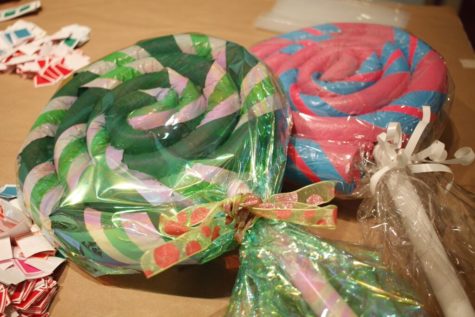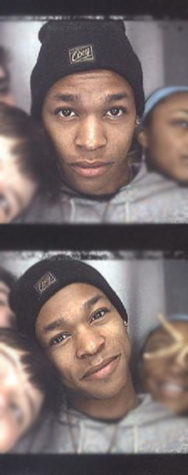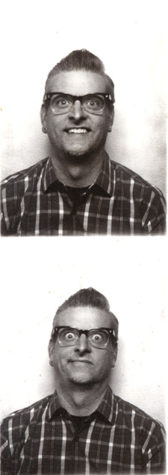
Swedish Fish or Peppermints? Oversize chocolate bars or paper mache gumdrops? Is a hand writing analyst relevant to the theme? Would visitors recognize a cardboard cutout of Ms. Gulch? As “aesthetic lead” of prom, I was faced with some tough decisions.
This June was the second year The Warhol partnered with GLSEN (now THRIVE) to host Pittsburgh’s Youth Pride Prom, the city’s LGBTQIA prom. This year’s theme, a Candyland and Wizard of Oz mash-up titled There’s No Place Like Candyland, allowed for the inclusion of a yellow brick road, candy-coated shoes, a tarot card reader and lollipops and cupcakes, among other delicacies.
Along with the final event, The Warhol’s Adil Mansoor, Paul O’Brien, GLSEN, and I organized three prom workshops. Held in The Warhol’s studio The Factory, the workshops were open to people 13–20 years old, LGBTQIA and allies from across the Pittsburgh region, to brainstorm, collaborate, mingle, and create activities and decorations for prom.
I sat down with Paul Matarrese, The Warhol Store’s manager, and Qjuan Taylor, a recent high school graduate and prom workshop participant, with the intention of having a multi-generational conversation about prom. Our conversations often steered in varied directions, with the common thread of being grateful to be involved in an event so impactful to LGBTQIA youth.

Qjuan Taylor is an artist and activist based in Pittsburgh. He graduated from Pittsburgh’s CAPA in 2015, where he was a vocal and musical theater major. Qjuan has participated in Pittsburgh’s Youth Pride Prom, planning and attending, for the past three years. He also established the name/theme for this year’s prom, There’s No Place Like Candyland.
Adrian Gordon: Tell me about your role in helping organize prom.
Qjuan Taylor: Well, the first time, I just attended. The second time, I was on the planning committee. This time I kind of made the name for it. We were closing our first meeting, and everybody said about four words, and I said, “There’s No Place Like Candyland,” and they said, “Oh my gosh, Wizard of Oz and Candyland!” I didn’t know that they were going to go so far as to actually do it, but it just happened.
AG: What was it like growing up in Pittsburgh for you as someone—well, I don’t know how you identify.
QT: Well, I used to identify as someone who was bi, then gay, and now I just don’t identify in a way. I’m just Qjuan. I don’t like to have a label. I mean, if my friends call me gay, I won’t really get too mad. But if someone asks me my orientation, I’ll tell them I’m just me. I like what I like.
AG: I came of age in Pittsburgh in the early 2000s, and at the time how you identified was a big deal. Queer was the only label you could choose that wasn’t really a label. Now I see more teens like you who say, “I’m me,” which is really refreshing.
QT: Yeah, and I think it’s because all of the changes. I mean, we just had gay marriage legalized. I personally feel like even though it’s not helping every problem in the world, it’s a step. And the fact that steps are being made in America, it’s just helping everything get better. I feel like it’s helping people be more accepting with themselves and more accepting with other people, because they’re realizing, “Oh, this is changing, something’s changing,” and I think that’s why everyone’s so comfortable saying, “Oh, I’m just me.” They don’t feel like they’re obligated to give themselves a title.
AG: Do you have one moment from this year’s prom that you remember as being especially memorable?
QT: I have too many memories, actually! Well, this year’s prom, the most memorable is the fact that my best friend came with me, and we had a blast. I love her to death. And we loved the fact that the photobooth was free all night. Me, her, and my other friend, all three of us, we were just being silly, being goofy, and we had a great time. I think that’s the best memory for me. And making new friends and connections, that’s a great memory for me.
AG: With growing mainstream acceptance of queer youth, and queer identities in general, do you feel that queer proms will remain necessary in the future?
QT: It all depends. I can’t tell the future. It depends on how the world changes, and if it changes for the better and we get more accepting. After gay marriage was legalized, people think anything can happen. As soon as people see one brick wall get torn down they realize, you know, we could tear down this entire prison that’s holding us down.

Paul Matarrese, who came of age in the late 1980s, was working in The Warhol Store the night of Youth Pride Prom. Matarrese posted the following to his Facebook page after seeing the prom: I’m at work and maybe getting a little verklempt. It’s the annual Youth Pride Prom. I have to say it’s amazing to work somewhere with so many welcoming, inclusive, progressive people. At times, in my bubble, I forget that the rest of the world isn’t like this (even if recent events have reminded me of that.) But, through work like this; one day, the rest of the world can be like this.
Adrian Gordon: Do you think having an alternative to traditional prom is necessary?
Paul Matarrese: I guess so, yeah, I think it’s important for different people, different minorities, to have safe space, where they can be who they are, act how they want, without fear of reprisal and repercussions. So even though, you know, we’re becoming more mainstream and more part of the broader culture, it’s still necessary to have our own space.
AG: So with the recent ruling in favor of the federal legalization of same-sex marriage and growing acceptance of queer youth autonomy, do you think that queer proms will remain necessary in the future, or as necessary as they are now?
PM: I don’t know, I mean it’s kind of funny. I was just reading a blog post about how Gay Pride has become this street party for straight youth. And so I guess that’s the other edge of the sword, that with acceptance, you then have this participation from the mainstream culture. So I don’t know if Pride, let alone gay prom, will continue into the future, because it is becoming this other thing. Less political, more of a party. Which there are benefits to, I guess, as well. But I don’t know, I’m a little too old and political for that.
AG: And now that all of that energy has been funneled into same-sex marriage, where will that kind of passion come from to address things our communities are facing like poverty, lack of anti-discrimination bills and transgender rights, things that haven’t been addressed because we’ve been so focused on marriage?
PM: And those are issues that really got short shrift. It’s odd that we fought so long and hard to be in the military and then for marriage when I feel like the movement used to be more about dismantling these types of structures, tearing down the patriarchy, and instead we’re just fighting to become part of it. And as we do that, and especially as a cisgender white man, there’s a lot of privilege that comes along with me, that then excludes others.
AG: It’s a recent phenomenon that the museum has been focusing gallery talks on queer issues in Warhol’s life and trying to address Warhol’s identity in a more direct way through our interactions with museum visitors. When I was an intern here I didn’t see much of that, and that was in 2005.
PM: Yeah, there wasn’t. And that was really a reflection of the times. So everyone was more closeted, The Warhol was more closeted. And I’ve been here 17 years, and there really has been a change. Even in artwork that you can present, programs that you can present, aren’t seen as being offensive, or too out there, or too whatever. But there’s this queering of American culture.
Thanks to The Warhol’s Adil Mansoor and Paul O’Brien and GLSEN’s Vanessa Davis and Nataly Shisman. Pittsburgh’s 2016 Youth Pride Prom will be held June 4, with more details forthcoming.

